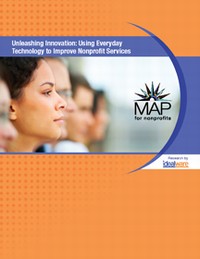 We talk to a lot of people who want to improve the way their organizations use technology, but who feel innovation is a luxury that limited staff time and budgets won’t allow. Can their nonprofits take better advantage of available technologies to improve the services they deliver and the ways in which they deliver them?
We talk to a lot of people who want to improve the way their organizations use technology, but who feel innovation is a luxury that limited staff time and budgets won’t allow. Can their nonprofits take better advantage of available technologies to improve the services they deliver and the ways in which they deliver them?
Our new research shows that they can. Working with our new partners at MAP for Nonprofits, we surveyed 180 Minnesota human services organizations about the technologies they were using, and then followed up with 13 of them in detailed interviews. This week we  released a free report detailing our findings.
released a free report detailing our findings.
What did we learn? For one thing, perception can be a barrier. People often think of innovation as cutting-edge technology—flashy, futuristic things like jet packs, flying cars and computers that integrate with our homes—but we found many nonprofits using existing technology to successfully innovate in more subtle ways. Even better, many of their solutions were both low-cost and effective, and therefore easier to implement—and easier for other organizations to replicate.
In one example that’s elegant in its simplicity, a staff member at a small organization observed that, while all the teens in a mentoring program carried cell phones and used them frequently, few would answer phone calls or emails. She began using text messages to communicate with them, and her free solution has substantially increased the number of teens attending programs.
Based on our results, I believe other organizations can better connect their needs with technology to improve the ways they serve constituents. Our research shows that such solutions don’t necessarily require a significant investment or in-depth planning process. We did, however, find four core common elements:
1. Identifying Needs: The organizations we talked to typically innovated their solutions to address core day-to-day inefficiencies or problems, or other opportunities to improve their service delivery, by taking the time to step back and assess what they could be doing better, or differently.
2. Understanding Technology: The organizations were generally aware of the technologies available to them—both those they already had, and other affordable solutions relevant to their needs—and took the time to educate themselves about available options.
3. Connecting Needs and Technology: The majority of the organizations we talked to had some catalyst for their innovation, often one external to the organization. In many cases, there was a specific step that helped them connect their needs with a technology solution.
4. Effecting Change in the Organization: Finally, innovation will fail without support—the successful organizations we spoke to took steps to make sure their organizations were on board with the solutions being implemented, and that sufficient resources were available to see them through to completion and to sustain them in the future
Download Unleashing Innovation: Using Everyday Technology to Improve Nonprofit Services to read more. We’re excited about what we learned, and think it can benefit nonprofits in all areas, not just human services. For any organization to be able to use straightforward, inexpensive technology to provide higher quality services and create opportunities to do more with less, innovation is something they can no longer afford not to embrace.
Laura Quinn is the executive director of Idealware, a nonprofit that provides impartial research, writing, and training about software for nonprofits.


COMMENTS